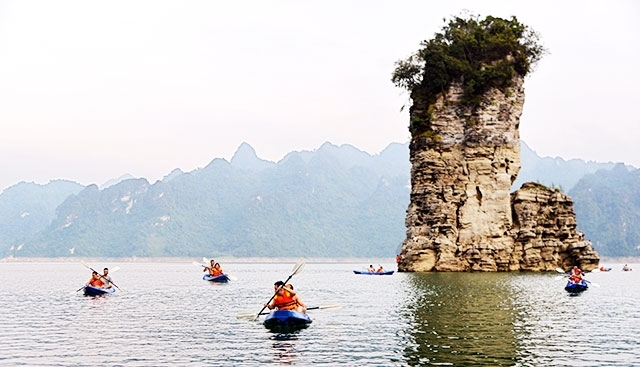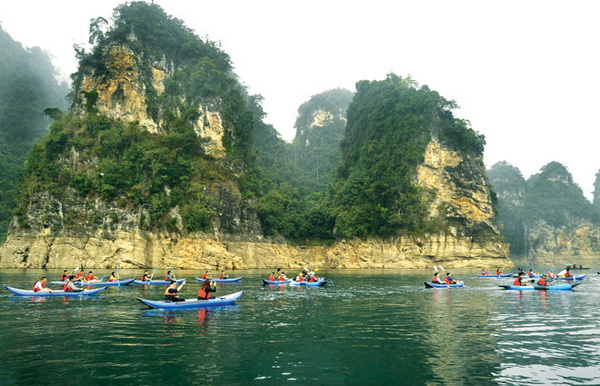On February 13, Tuyen Quang Province announced the Prime Minister’s decision to recognise Na Hang-Lam Binhnature reserve in the northern province of Tuyen Quang as a national special tourist attraction.

Na Hang-Lam Binh nature reserve was recognised as a national special tourist attraction.
Located among vast forests along the banks of Gam and Nang rivers, Na Hang – Lam Binh has a diverse ecosystem with numerous rare animals and plants, amazing caves, poetic natural waterfalls, fanciful natural landscapes, fresh climate, and many unique cultural customs of Tay, Dao and Mong ethnic minority groups.
The nature reserve covers the communes of Lang Can, Khuon Ha, Thuong Lam and Phuc Yen in Lam Binh District as well as those of Nang Kha, Thanh Tuong, Son Phu, Hong Thai, Thuong Nong, Thuong Giap, Yen Hoa, Con Lon, Sinh Long, and Khau Tinh along with Na Hang Town in Na Hang District.
The famous landscapes are associated with legends of their origin, creating an attractiveness and mystery. In the journey from the Tuyen Quang hydroelectric lake to Song Long Cave, visitors can bathe in the clear blue water of famous waterfallssuch as Nam Me and Nam Nhi. In addition, tourists seem to come to the fairy regions with legends about Tien – Khach and 99 mountains and the fairy tale of Phac Phien flowers as well as stories about the romantic love between a woodcutter and a princess – the daughter of King Thuy Te at Pac Ban waterfall and about a long-haired girl who sacrificed her life beside Tat Thoc waterfall to bring water to her village.
Many archaeological relics from the Neolithic and metal ages were found in Na Hang – Lam Binh nature reserve. Notably, the relic of a unique burial service with two sea snails placed onto the eyes of the deceased was one of the most special relics with high scientific value. The archaeological site was discovered for the first time in Vietnam and Southeast Asia. The carved artefacts were also found in the ancient tomb area in Nguom Hau cave and a vestige-burial relic belonging to the Hoa Binh cultural system dating back about 13,000 years also appeared at Phia Vai Cave. The findings and initial studies showed that with their creativity, the owners of the Neolithic and metal ages turned the place into a dynamic, creative and prosperous land and extended the exchanges with surrounding areas.
The nature reserve also has traces of artistic architecture from under the Tran, Le and Nguyen feudal dynasties such as the Phuc Lam, Ong, Don Thai and Ba pagodas, along with the Pac Ta, Pu Bao, Ne and Na Them temples. The traditional culture of the residents in the districts of Na Hang and Lam Binh is quite diverse, particularly regarding fairy tales and folk legends. Almost all the mountains, rivers, and streams are associated with legends, while many natural phenomena are vividly explained.
Na Hang – Lam Binh land is home to many ethnic groups, mostly Tay and Dao ethnic minority people. Therefore, cultural and art activities of the locals here are very diverse, in association with stilted houses and traditional folk songs. Tay ethnic minority people are famous for several typical handicraft professions including brocade weaving and knitting; while beeswax painting and embroidery are traditional occupations of Dao people.
Visitors will have the opportunity to join traditional festivals and enjoy specialties such as corn wine, dried buffalo meat, forest vegetables and forest honey, as well as experience the daily lives, holidays, customs and folk games of the people.
Tourists will surely be impressed with the traditional stilt houses, terraced fields formed hundreds of years ago, imposing waterfalls and various caves, creating a beautiful, majestic and pristine scenery.

Currently, there are about 294 species of birds as well as around 88 species of animals, including numerous rare species such as phuong hoang dat (buceros bicornis), francolin, red-headed woodpecker, tigers, leopards, horse bears, civets, squirrels and eight species of primate. In particular, the Tonkin snub-nosed monkey is an endemic species of Vietnam that was listed in the Red Book.
Notably, Na Hang – Lam Binh nature reserve consists of the largest primary forest in northern Vietnam with 1,162 species of higher plants.
It can be said that the recognition of Na Hang – Lam Binhreserve as a national special tourist attraction has contributed significantly not only to its development but also to the tourism sector of Tuyen Quang Province. The recognition is also an important basis for the locality to coordinate with Bac Kan Province to prepare a dossier to seek UNESCO recognition of Ba Be-Na Hang as a world natural heritage site.
Tuyen Quang provincial agencies have carried out a plan to conserve and promote the values of the Na Hang – Lam Binhnature reserve, focusing on completion of functional sub-areasin the Na Hang ecotourism area; developing wharves at thehydroelectric lake and at tourist destinations; building PhiengBung forestry park and promoting spiritual tourist sites. The local authorities have also paid much attention to making detailed plans for other tourist areas, boosting tourism development in association with protection of ecological environment, and watershed protection forests. The investment has been enhanced for tourism products of the districts’ strengths, such as eco-lake, adventure and festive tourism types at Khuoi Nhi and Khuoi Sung waterfalls and Song Long and Khuoi Pin caves, along with homestays at Nam Dip, Na Tong and Na Dong cultural villages.
Chairman of Lam Binh District People’s Committee Nguyen Van Dung said that the local People’s Committee has issued a plan to promote the tourism potential of the district as well as gradually formed and developed its typical tourism brand,attracting more investment into services, contributing to economic development and creating jobs for locals. The improvement of the quality of services and making more products and souvenirs to serve visitors have been accelerated in recent times.
According to the Secretary of Na Hang District Party Committee, Hoang Anh Cuong, under the master plan for tourism development until 2020, with an oritentation to 2030, the district have focused on completing the detailed plan of tourist areas and destinations in the locality as well as developed the functional subdivisions in Na Hang ecotourism area such as a welcome gate at Co Yeng Pass, the wharf at the Tuyen Quang hydroelectric lake, the cultural and tourism village (Dao Tien ethnic group) in Khau Trang Village, Hong Thai Commune, and cultural and tourism village of Tay ethnic group in Na Kha Village, Nang Kha Commune.
National relic sites, including Phia Muon spiritual tourist site (national relic site) in Son Phu Commune, Na Hang District and Central Special Printing Office, as well as several provincial relics, will be preserved and promoted. The district strives to welcome over 130,000 visitors, including over 2,000 international ones, and earn over VND100 billion per year by 2020.